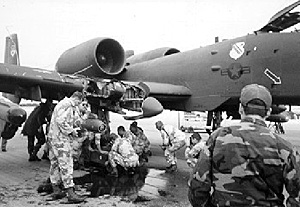 A long-time Harpoon player and contributor, wrote:
A long-time Harpoon player and contributor, wrote:
I have been meaning to ask you about Harpoon rule 8. 2 Aircraft Damage. I'm running a game and one of the players asked about the surviving aircraft and re-attacking them to ensure their destruction.
On any other aircraft, this would be rated as Heavy damage, but on an A-10 this is light damage to the airframe. (US Air Force)
I was kinda stuck -do previously hit aircraft suffer any penalties for the damage they have? The situation arose again when the limping aircraft were sighted by another patrol. What methods should one use if the player wants to be sure it is a downed aircraft and not just a smoker that will limp home and re-join the fight later after repairs?
My answer: (by Larry Bond)
Normally the killed/damaged roll is made after the battle, because historically many of the aircraft that were “killed” did make it back, even though they took no further part in the battle. This is definitely the best procedure in most games, both for simplicity and to mirror actual doctrine. Pilots who followed cripples to finish them off abandoned their comrades still in combat, and also ignored other enemy aircraft that were still capable of accomplishing their mission.
If players want to finish off the stragglers, they have to know they are not dead, which means the aircraft damage roll must be made immediately after the hit. Resolving this during the combat will definitely slow play down, and if large numbers of aircraft are involved, it could bring the game to a crashing halt.
The players can either use the simple 50/50 roll to see whether it is destroyed or damaged, or they can use the D100 roll described in 8. 2. 1. This can give a result of Killed, Critical, Heavy, or Light damage. How a plane acts at each damage level must now be defined:
Killed:
It immediately ceases to fly and falls to the earth. Pieces fall off. There is a large IR bloom, following which it disappears from radar and IR. It’s dead, Jim.
Critical:
The only thing keeping this plane in the air is its ignorance of how badly damaged it really is. It cannot use any speed over cruise. All weapons systems, sensors, and defensive countermeasures are down. Its maneuver rating is 0. 5/0. 0, depending on whether it is fully or lightly loaded (hint!) .
Heavily damaged:
This aircraft’s ability to . y is severely impaired. It cannot use any speed over cruise. All weapons and sensors are down. Its maneuver rating is halved, minimum 0. 5/0. 5.
Lightly damaged:
This plane is no longer capable of accomplishing its mission. Roll D6 on the following table:
- 1: Pilot wounded. Cannot attack, Maneuver rating reduced by 1/3.
2-3: Engine damaged. It cannot use any speed over cruise. Maneuver rating is halved.
4-5: Aircraft structure damaged. It cannot use any speed over cruise. Maneuver rating is 0. 5/0. 5.
6: Offensive weapons system damaged. It cannot release any ordnance offensively. There is a 50% chance that it cannot jettison any ordnance, either.
Each time an aircraft is hit, roll on the table in 8. 2. 1. The first hit imposes the listed casualty. Second and later hits add to the severity of the damage:
- Any hit on a Critically damaged aircraft kills it.
- Heavy Damage to a Heavily damaged aircraft kills it.
- Heavy Damage to a Lightly damaged aircraft makes it Critically Damaged.
- Light Damage to a Heavily damaged aircraft makes it Critically Damaged.
- Light Damage to a Lightly Damaged aircraft, if it is not the same type, makes it Heavily Damaged. If it is the same result, ignore it.
If players use the 50/50 system, treat all damage as Heavy damage, i. e., a second hit kills the aircraft.
Obviously, this ruthlessly oversimplifies the many horrible things that can happen when aircraft and exploding warheads interact, but it will define how an aircraft that has been “hit” behaves afterward in the game.
After resolving its damage, the players continue their turn with damaged aircraft behaving as their damage indicates. In most cases, damaged aircraft will head in the general direction of away, but a plane with light damage resulting in a sensor or weapons hit might stay in the fight, to help distract or decoy their opponent. This happened historically.
Common sense should apply. If somebody wants to follow a “kill” to finish him off, then he’s out of the dogfight. If a player with a crippled plane wants to stay in the fight (“I'm already dead, so I might as well suck up another missile”), activate the secret autopilot that takes control of the plane and heads it toward home.
Please let us know if you use these rules or some variant of them in your game.
BT
Back to The Naval Sitrep # 26 Table of Contents
Back to Naval Sitrep List of Issues
Back to MagWeb Master Magazine List
& copy Copyright 2004 by Larry Bond and Clash of Arms.
This article appears in MagWeb.com (Magazine Web) on the Internet World Wide Web.
Other military history and related articles are available at http://www.magweb.com